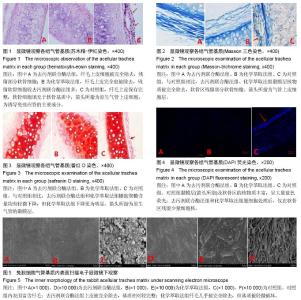| [1] Sukumaran R,Nair RA,Jacob PM,et al.Extramedullary Plasmacytoma of the Trachea.Head Neck Pathol. 2014; 8(2):220-224. [2] Angelelini GD,Penny WJ,el-Ghamary F,et al.The incidence and significance of early pericardial effusion after open heart surgery.Eur J Cardiothorac Surg. 1978; 1:165-168.[3] Kojima K,Vacanti CA.Tissue engineering in the trachea.Anat Rec (Hoboken). 2014;297(1):44-50.[4] Ott LM,Weatherly RA,Detamore MS.Overview of tracheal tissue engineering :Clinical need drives the laboratory approach.Ann Biomed Eng. 2011,39:2091-2113.[5] Gonfiotti A,Jaus MO,Barale D,et al.The first tissue-engineered airway transplantation: 5-year follow-up results.Lancet.2014;383(9913):238-244.[6] Haykal S,Salna M,Waddell TK,et al.dvances in Tracheal Reconstruction.Plast Reconstr Surg Glob Open.2014;2(7):e178.[7] Góra A,Pliszka D,Mukherjee S,Ramakrishna S.Tubular Tissues and Organs of Human Body--Challenges in Regenerative Medicine.J Nanosci Nanotechnol. 2016; 16(1):19-39.[8] Langer R,Vacanti JP.Tissue engineering. Science, 1993;260: 920-926.[9] Roosens A,Somers P,De Somer F,et al.Impact of Detergent-Based Decellularization Methods on Porcine Tissues for Heart Valve Engineering.Ann Biomed Eng. 2016;44(9):2827-2839.[10] Dong J,Mo X,Li Y,et al.Recent research progress of decellularization of native tissues.Sheng Wu Yi Xue Gong Cheng Xue Za Zhi.2012;29(5):1007-1013.[11] 章方彪,史宏灿,张卫东,等.兔脱细胞同种异体气管基质衍生材料的形态特征及其生物力学分析[J].中华实验外科杂志,2014,31(3):573-576.[12] Sun F,Pan S,Shi HC,et al.Structural integrity, immunogenicity and biomechanical evaluation of rabbit decelluarized tracheal matrix.J Biomed Mater Res A.2015;103(4):1509-1519.[13] Yang H,Tan Q,Zhao H.Progress in various crosslinking modification for acellular matrix.Chin Med J (Engl). 2014; 127(17):3156-3164.[14] Tomizawa Y.Late spontaneous nonanastomotic transgraft hemorrhage from biological material-impregnated fabric vascular graft may be due to autologous tissue detachment: a clinical hypothesis. Artif Organs.2014;38(12):1058-1060. [15] Pimenta FR,Ferreira MD,Gir E,et al.Care and specialized clinical follow-up of nursing professionals who have been victims of accidents with biological material. Rev Esc Enferm USP.2013;47(1):198-204. [16] Crapo PM,Gilbert TW,Badylak SF.An overview of tissue and whole organ decellularization processes.Biomaterials.2011;32(12):3233-3243. [17] Rice RD,Ayubi FS,Shaub ZJ,et al.Comparison of Surgisis, AlloDerm, and Vicryl Woven Mesh grafts for abdominal wall defect repair in an animal model.Aesthetic Plast Surg. 2010;34(3):290-296. [18] Scarritt ME,Pashos NC,Bunnell BA.A review of cellularization strategies for tissue engineering of whole organs.Front Bioeng Biotechnol.2015;3:43.[19] Faulk DM,Johnson SA,Zhang L,et al.Role of the extracellular matrix in whole organ engineering.J Cell Physiol.2014;229(8):984-989.[20] Zhou J,Fritze O,Schleicher M,et al.Impact of heart valve decellularization on 3-D ultrastructure, immunogenicity and thrombogenicity. Biomaterials. 010;31(9): 2549-2554.[21] Annunziata C,Alessandra C,Attila T,et al.Inflammation in tissue engineering: the Janus between engraftment and rejection.Eur J Immunol.2015;45(12):3222-3236.[22] Keane TJ,Swinehart IT,Badylak SF.Methods of tissue decellularization used for preparation of biologic scaffolds and in vivo relevance.Methods.2015;84:25-34.[23] Crapo PM,Gilbert TW,Badylak SF.An overview of tissue and whole organ decellularization processes. Biomaterials.2011;32(12):3233-3243.[24] Maghsoudlou P,Totonelli G,Loukogeorgakis SP,et al.A decellularization methodology for the production of a natural acellular intestinal matrix.J Vis Exp. 2013;(80): e50658.[25] Perea-Gil I,Uriarte JJ,Prat-Vidal C,et al.In vitro comparative study of two decellularization protocols in search of an optimal myocardial scaffold for recellularization.Am J Transl Res.2015;7(3):558-573.[26] Shupe T,Williams M,Brown A,et al.Method for the decellularization of intact rat liver.Organogenesis. 2010;6(2):134-136.[27] Cebotari S,Tudorache I,Jaekel T,et al.Detergent decellularization of heart valves for tissue engineering: toxicological effects of residual detergents on human endothelial cells.Artif Organs.2010;34(3):206-210.[28] Xu H,Xu B,Yang Q,et al.Comparison of decellularization protocols for preparing a decellularized porcine annulus fibrosus scaffold.PLoS One.2014;9(1):e86723.[29] Badylak SF.The extracellular matrix as a biologic scaffold material. Biomaterials. 2007;28:3587-3593.[30] Uriel S,Labay E,Francis-Sedlak M,et al.Extraction and assembly of tissue-derived gels for cell culture and tissue engineering.Tissue Eng Part C Methods. 2009; 15:309-321. [31] Farag A,Vaquette C,Theodoropoulos C,et al.Decellularized periodontal ligament cell sheets with recellularization potential.J Dent Res. 2014;93(12):1313-1319.[32] Jungebluth P,Go T,Asnaghi A,et al.Structural and morphologic evaluation of a novel detergent-enzymatic tissue-engineered tracheal tubular matrix.J Thorac Cardiovasc Surg. 2009;138(3):586-593.[33] Illien-Jünger S,Sedaghatpour DD,Laudier DM,et al.Development of a bovine decellularized extracellular matrix-biomaterial for nucleus pulposus regeneration.J Orthop Res.2016;34(5):876-888.[34] Yu BT,Li WT,Song BQ,et al.Comparative study of the Triton X-100-sodium deoxycholate method and detergent-enzymatic digestion method for decellularization of porcine aortic valves.Eur Rev Med Pharmacol Sci.2013;17(16):2179-2184. |

